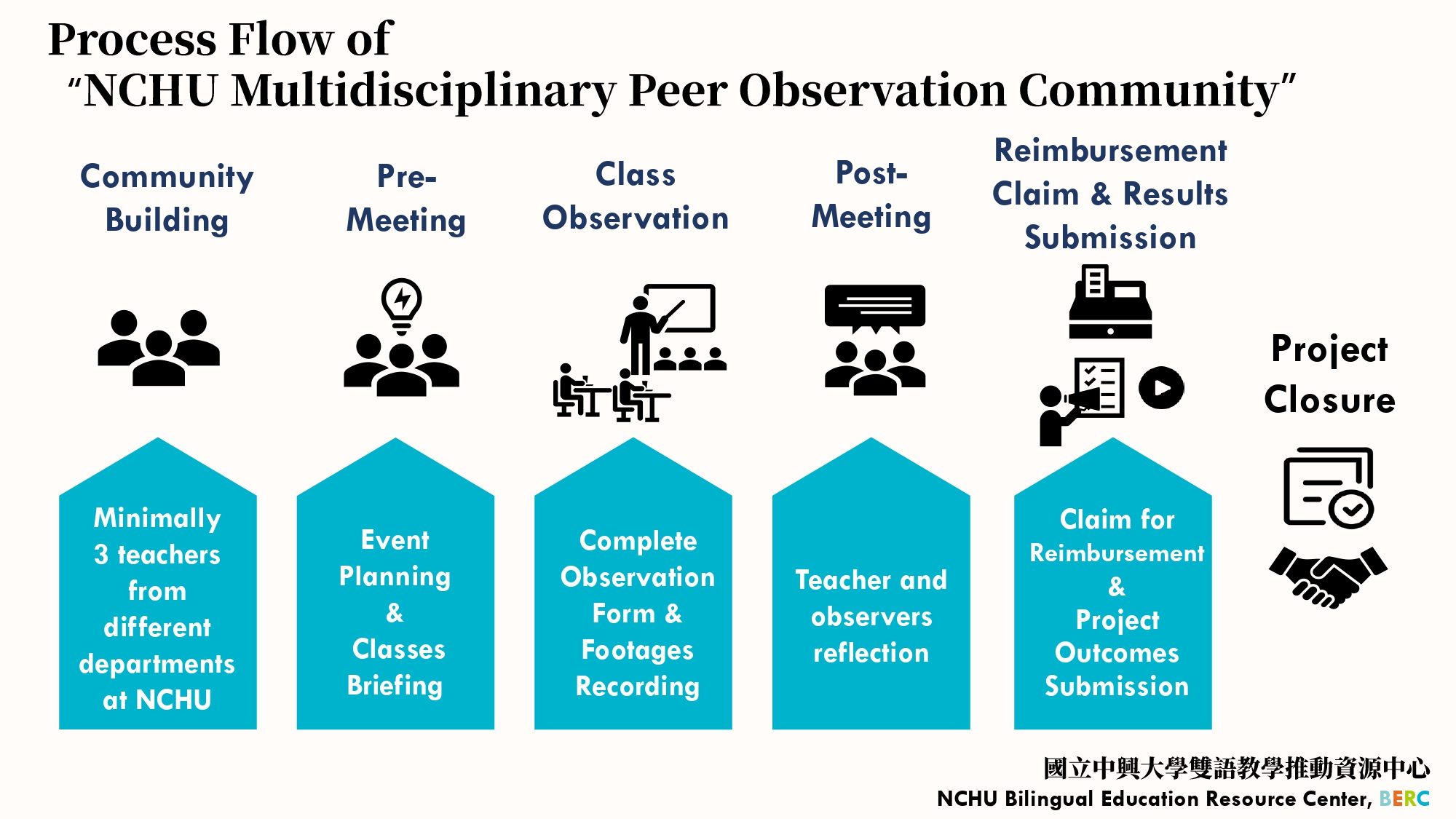- HOME
- 【Teacher Incentive】NCHU Multidisciplinary Peer Observation Community
【Teacher Incentive】NCHU Multidisciplinary Peer Observation Community
Date of Publication:2023-06-28

Rationale & Objective
The following regulations are to motivate EMI (English as a Medium of Instruction)/ESAP (English for Specific Academic Purposes) teachers from different departments to form the multidisciplinary peer observation communities. The Bilingual Education Resource Center (“the BERC”) has formulated this proposal for promoting peer observation, developing professional growth mindset and the exchange of cross-disciplinary teaching experiences and building teacher support systems.
Applicant Eligibility
- A multidisciplinary peer observation community shall be composed of a minimum of 3 teachers from different departments at NCHU. Each teacher may only join in one community.
- A full-time instructor at NCHU shall serve as the community facilitator and be responsible for event planning, coordinating community activities and submit the relevant outcomes.
- The community facilitator shall submit a completed Application Form (click here for Appendix 1) to gisele816@nchu.edu.tw by September 15th 2023.
- At least one community member offers the course which meets the definition of "EMI, English as a Medium of Instruction" or "ESAP, English for Specific Academic Purposes" as referred in《NCHU Classification Criteria for English-taught Courses》(or Appendix 2).
Management
- Frequency:Each member shall conduct at least one 50-minute class (or teaching demonstration) and invite colleagues into their classes to observe lessons; additionally, serves as an observer (including completing observation form and participating in relevant pre-/post meetings) at least once along the implementation period.
- Event Planning
- Before the observation:
- Implementation:
- Peer Observation:Observers shall attend the instructor's class and complete the observation form (click here for Appendix 2) and return to the community facilitator along with all the observation forms the event images (1-3 photos) records and a 10 minutes footage clip.
- Teaching Demonstration:An instructor shall perform a 50-minute teaching demonstration. Participants shall complete the observation form (see Appendix 2) and return to the community facilitator along with all the observation forms the event images (1-3 photos) records and a 10 minutes footage clip.
- Post-Observation Meeting:Post-Observation Meetings shall be held to facilitate critical reflections and challenging assumptions in classroom. Meeting minutes (click here for Appendix 3) shall be submitted to the community facilitator along with the event images (1-3 photos) records.
Review & Approval
- The Director of the BERC serves as the Proposals Review Committee convener. Grant amounts shall be reviewed and determined based on the Event Planning and the previous implementation outcomes. The community facilitator will be notified after the proposal and grant amounts are approved at the Office of Academic Affairs management meeting.
- The ceiling of subsidy is set at NTD 60,000 per eligible case. This funding is used to support the operation and activity needs of the community. The relevant budget allocation items will be handled in accordance with the《Principles of Subsidy and Fund Use for the Higher Education Sprout Project》, 《Universities and the Funding Standard Table for Donations, Subsidies, and Sponsored Projects of the Ministry of Education》and Policies & Procedures of the Office of Accounting.
- Claims for reimbursement must be completed by Nov. 30th 2023.
Monitoring & Evaluation
- Facilitator shall submit the following documents within 10 working days after the implementation period.
- All observation forms
- All Meeting Minutes
- All event images records and footage clips
- The outcomes of the communities shall be displayed on the BERC’s website for non-profit uses and academic promotion.
- The implementation outcomes will be the reference and evaluation indicator of the future applications.

